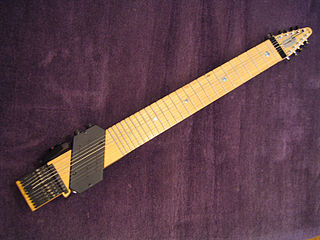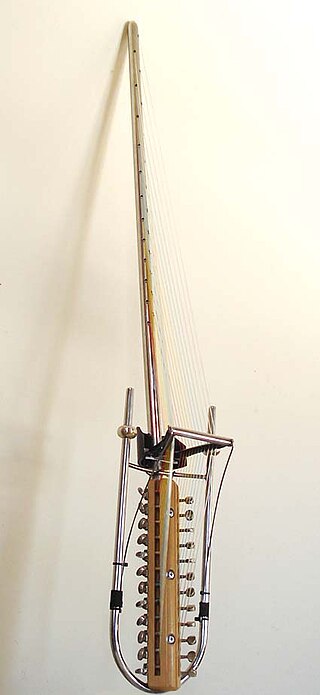 | |
| String instrument | |
|---|---|
| Classification | String |
| Hornbostel–Sachs classification | 321.322 (Composite chordophone) |
| Inventor(s) | Dave Bunker |
| Developed | 1985 |
| Related instruments | |

The Bunker Touch Guitar is a double-necked touch guitar developed by Dave Bunker.
 | |
| String instrument | |
|---|---|
| Classification | String |
| Hornbostel–Sachs classification | 321.322 (Composite chordophone) |
| Inventor(s) | Dave Bunker |
| Developed | 1985 |
| Related instruments | |

The Bunker Touch Guitar is a double-necked touch guitar developed by Dave Bunker.
Until guitarist Jimmie Webster first popularized his Illustrated Touch System in 1952, [1] all guitars had been strummed. But with Webster's single-neck touch-style guitar and then Dave Bunker's headless, [2] [3] double-neck, DuoLectar touch guitar, these new instruments, while appearing similar to traditional strummed guitars, [4] actually employed an innovative tapping technique. [5]
Dave Bunker developed and patented the first double-necked tap/touch-style guitar, [6] which he called the Duo'Lectar. [7]
The DuoLectar [8] was conceived, built, and played by Dave Bunker in 1955. [9] At the suggestion of Irby Mandrell (father of country singer Barbara Mandrell), Bunker changed the tuning configuration of the lower neck to conform to a standard bass. [10] It was introduced to a live, national TV audience on the Ozark Jubilee, hosted by Eddy Arnold and Red Foley, [11] and then in 1960, Bunker demonstrated his double-necked instrument for the Portland Oregonian newspaper. [12]
With the addition of patented refinements, [13] [14] the Duo'Lectar became popularly known as the Bunker Touch Guitar. [15]
The DuoLectar was later seen in headline shows at the Golden Nugget in Las Vegas from 1964 through 1974. [16]
Because of its influence on the guitar industry, Seattle's EMP Museum (now called Museum of Pop Culture) displays a DuoLectar guitar and features a video interview with Dave Bunker. [17]
In 1985, Bunker developed a specialized electronic mute for the instrument, later patented. [18] This new configuration became known as the Bunker Touch Guitar. [19]
Except for its twin necks, the Bunker Touch Guitar is similar in appearance to a typical guitar. However, it is dissimilar in its style of play. Strings on the Bunker Touch Guitar are not strummed or plucked, as in the traditional, single-necked guitar. Instead, all strings respond to touch or tap. On the Bunker Touch Guitar, a note sounds when a string is held down and stops when it is released. The left hand plays bass lines on the lower neck, while the right hand simultaneously plays lead lines on the upper neck. It has no head at the top end of the necks (as on conventional guitars) because its tuning keys are located at the base-edge of the instrument.
The importance of the early touch guitar to the standard single-neck guitar's evolution was acknowledged by its display at Seattle's Experience Music Project Museum (now called Museum of Pop Culture) when it opened in 2000. Dave Bunker detailed the development of his invention in a videotaped interview conducted by the museum. [20] His uniquely designed touch guitar [21] [22] continued to mature, [23] and was featured in headline shows at the Golden Nugget in Las Vegas from 1964 through 1974. [24]
Selected patents incorporated specifically into the Bunker Touch Guitar have also been used in other contemporary guitar designs. [25] The touch technique has been popularized by guitarists Eddie Van Halen, Stanley Jordan, Steve Vai, and Jeff Healey. [26]
Some contemporary artists have gone forward to utilize the tapping method with their own touch-style guitars, including Emmett Chapman, Eddie Van Halen, Stanley Jordan, Steve Vai, Jeff Healey, Markus Reuter, Chuck Churchman, [27] and Sergio Santucci. [28] Despite this, the touch guitar genre is still a small segment of the industry. Manufacturers that produce the specialized instruments include Bunker Guitars, [29] Warr Guitars, [30] and Mobius (Magatar). [31]

The bass guitar, electric bass or simply bass is the lowest-pitched member of the guitar family. It is a plucked string instrument similar in appearance and construction to an electric or acoustic guitar, but with a longer neck and scale length. The bass guitar most commonly has four strings, though five- and six-stringed models are also relatively popular, and bass guitars with even more strings or courses have been built. Since the mid-1950s, the bass guitar has largely come to replace the double bass in popular music due to its lighter weight, the inclusion of frets in most models, and, most importantly, its design for electric amplification. This is also because the double bass is acoustically compromised for its range in that it is scaled down from the optimal size that would be appropriate for those low notes.

An electric guitar is a guitar that requires external amplification in order to be heard at typical performance volumes, unlike a standard acoustic guitar. It uses one or more pickups to convert the vibration of its strings into electrical signals, which ultimately are reproduced as sound by loudspeakers. The sound is sometimes shaped or electronically altered to achieve different timbres or tonal qualities from that of an acoustic guitar via amplifier settings or knobs on the guitar. Often, this is done through the use of effects such as reverb, distortion and "overdrive"; the latter is considered to be a key element of electric blues guitar music and jazz, rock and heavy-metal guitar-playing. Designs also exist combining attributes of the electric and acoustic guitars: the semi-acoustic and acoustic-electric guitars.

The guitar is a stringed musical instrument that is usually fretted and typically has six or twelve strings. It is usually held flat against the player's body and played by strumming or plucking the strings with the dominant hand, while simultaneously pressing selected strings against frets with the fingers of the opposite hand. A guitar pick may also be used to strike the strings. The sound of the guitar is projected either acoustically, by means of a resonant hollow chamber on the guitar, or amplified by an electronic pickup and an amplifier.

The Chapman Stick is an electric musical instrument devised by Emmett Chapman in the early 1970s. A member of the guitar family, the Chapman Stick usually has ten or twelve individually tuned strings and is used to play bass lines, melody lines, chords, or textures. Designed as a fully polyphonic chordal instrument, it can also cover several of these musical parts simultaneously.

Tapping is a playing technique that can be used on any stringed instrument, but which is most commonly used on guitar. The technique involves a string being fretted and set into vibration as part of a single motion. This is in contrast to standard techniques that involve fretting with one hand and picking with the other. Tapping is the primary technique intended for instruments such as the Chapman Stick.

A twelve-string guitar is a steel-string guitar with 12 strings in six courses, which produces a thicker, more ringing tone than a standard six-string guitar. Typically, the strings of the lower four courses are tuned in octaves, with those of the upper two courses tuned in unison. The gap between the strings within each dual-string course is narrow, and the strings of each course are fretted and plucked as a single unit. The neck is wider, to accommodate the extra strings, and is similar to the width of a classical guitar neck. The sound, particularly on acoustic instruments, is fuller and more harmonically resonant than six-string instruments. The 12-string guitar can be played like a 6-string guitar as players still use the same notes, chords and guitar techniques like a standard 6-string guitar, but advanced techniques can be challenging as players need to play or pluck two strings simultaneously.

The Appalachian dulcimer is a fretted string instrument of the zither family, typically with three or four strings, originally played in the Appalachian region of the United States. The body extends the length of the fingerboard, and its fretting is generally diatonic.

The Fender Musical Instruments Corporation is an American manufacturer and marketer of musical instruments and amplifiers. Fender produces acoustic guitars, bass amplifiers and public address equipment; however, it is best known for its solid-body electric guitars and bass guitars, particularly the Stratocaster, Telecaster, Jaguar, Jazzmaster, Precision Bass, and the Jazz Bass. The company was founded in Fullerton, California, by Clarence Leonidas "Leo" Fender in 1946. Andy Mooney has served as the chief executive officer (CEO) since June 2015.
The Fender Jaguar is an electric guitar by Fender Musical Instruments characterized by an offset-waist body, a relatively unusual switching system with two separate circuits for lead and rhythm, and a short-scale 24" neck. Owing some roots to the Jazzmaster, it was introduced in 1962 as Fender's feature-laden top-of-the-line model, designed to lure players from Gibson. During its initial 13-year production run, the Jaguar did not sell as well as the less expensive Stratocaster and Telecaster, and achieved its most noticeable popularity in the surf music scene. After the Jaguar was taken out of production in 1975, vintage Jaguars became popular first with American punk rock players, and then more so during the alternative rock, shoegazing and indie rock movements of the 1980s and 1990s. Fender began making a version in Japan in the mid-1980s, and then introduced a USA-made reissue in 1999. Since then, Fender has made a variety of Jaguars in America, Mexico, Indonesia and China under both the Fender and Squier labels. Original vintage Jaguars sell for many times their original price.

The Gravikord is a 24 string electric double bridge-harp invented by Robert Grawi in 1984, which is closely related to both the West African kora and the mbira. It was designed to employ a separated double tonal array structure making it possible to easily play cross-rhythms in a polyrhythmic musical style in a modern electro-acoustic instrument. The Gravi-kora is a similar instrument, also developed by Grawi, which is tuned identically to a traditional 21 string kora.

The following outline is provided as an overview of and topical guide to guitars:

A multi-neck guitar is a guitar that has multiple fingerboard necks. They exist in both electric and acoustic versions. Examples of multi-neck guitars and lutes go back at least to the Renaissance.
Tap guitar is a class of guitar that is played primarily by tapping on the strings. Any guitar can be played this way, but there are various specialty brands of instruments that are designed specifically for this technique.

A guitar controller is a video game controller designed to simulate the playing of the guitar, a string musical instrument. Guitar controllers are often used for music games such as Guitar Hero, Rock Band, Um Jammer Lammy: NOW! and GuitarFreaks. The controllers are played by holding down a colored fret button that matches a colored, on-screen note, while pressing the strum bar as the note passes through the target. The controllers also feature a whammy bar, which is used to bend notes and collect each game's equivalent of bonus energy. Different games and models of controllers have introduced additional features, such as effects switches, additional fret buttons, and fret touch pads. The fret buttons are colored usually in the order of green, red, yellow, blue, and orange.
Electric guitar design is a type of industrial design where the looks and efficiency of the shape as well as the acoustical aspects of the guitar are important factors. In the past many guitars have been designed with various odd shapes as well as very practical and convenient solutions to improve the usability of the object.
The Megatar is a stringed musical instrument designed to be played using a two-handed tapping technique. It is manufactured by the American company Mobius Megatar.

The touch guitar is a stringed instrument of the guitar family which has been designed to use a fretboard-tapping playing style. Touch guitars are meant to be touched or tapped, not strummed.

Experimental luthiers are luthiers who take part in alternative stringed instrument manufacturing or create original string instruments altogether.
The Fender Telecaster, colloquially known as the Tele, is an electric guitar produced by Fender. Together with its sister model the Esquire, it was the world's first mass-produced, commercially successful solid-body electric guitar. Its simple yet effective design and revolutionary sound broke ground and set trends in electric guitar manufacturing and popular music. Many prominent rock musicians have been associated with the Telecaster for use in studio recording and live performances, most notably Bruce Springsteen, Luis Alberto Spinetta, Keith Richards and George Harrison.

The Warr Guitar is an American-made touch guitar, a type of instrument that combines both bass and melodic strings on a single fretboard. Invented by Mark Warr, a musician from Thousand Oaks, California, it is related to the Chapman Stick, another two-handed tapping instrument. The Warr guitar is designed for either two-handed tapping or strumming. Warr guitars have between seven and 14 strings.
{{cite book}}: CS1 maint: others (link)Bunker's uniquely designed twin-necked Duo-Lectar guitar will ultimately become the very first such instrument to be granted a patent.
{{cite book}}: CS1 maint: location missing publisher (link) CS1 maint: multiple names: authors list (link)Bunker's patented mute was an ingenious, if seemingly simple, invention.
The contemporary Bunker Touch Guitar is a vastly refined version of the DuoLectar.
{{cite book}}: CS1 maint: others (link){{cite book}}: CS1 maint: others (link)Over the years Bunker came up with a series of patents - for muting the strings, for a guitar without a conventional head, and with tuning pegs on its body, for neck and bridge designs. He came up with ideas that others took and ran with.